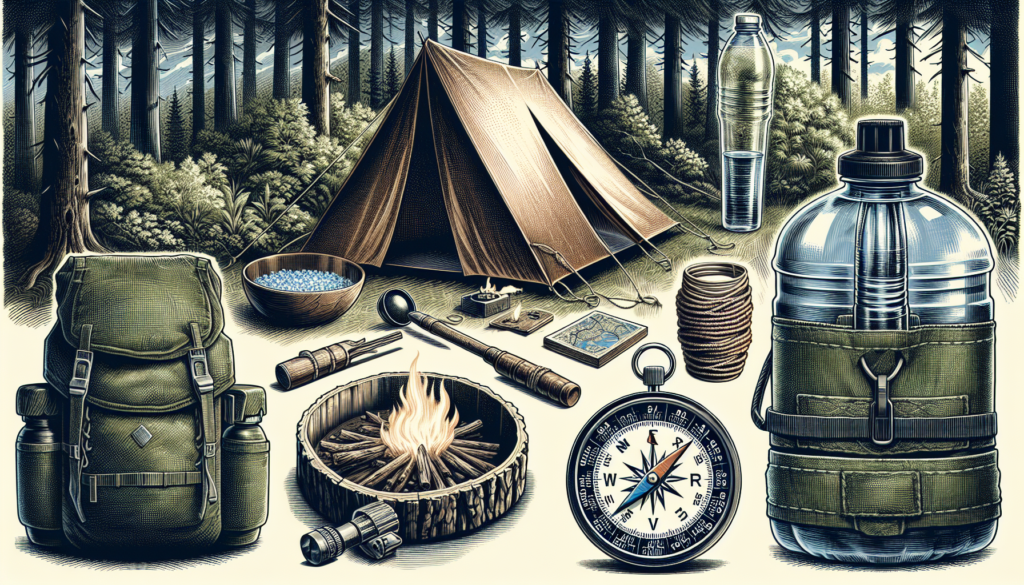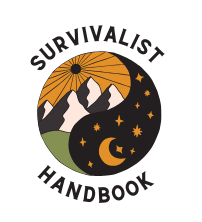Imagine stepping out into the great outdoors, surrounded by nature’s beauty and unpredictability. Whether you’re a seasoned adventurer or a beginner, our ‘outdoor survival basics‘ guide is here to ensure you have the knowledge and skills to handle any situation that may arise. From basic techniques to wilderness survival skills, we’ve got you covered. Whether you’re seeking primitive survival skills or a comprehensive checklist, our resources will equip you with the essentials for your outdoor adventures. So, let’s dive in and discover the fundamental survival skills that will have you confidently navigating the wilderness in no time. Outdoor Survival Basics, here we go!
Understanding the Importance of Outdoor Survival
Welcome to our comprehensive guide on understanding the importance of outdoor survival. In this article, we will explore various aspects of outdoor survival skills, the potential risks and dangers in the wilderness, and how to develop a survival mindset to ensure your safety and well-being in any outdoor situation.
Recognizing the need for outdoor survival skills
Knowing basic outdoor survival skills is crucial for anyone who enjoys spending time in nature. Whether you are an experienced hiker, a casual camper, or an adventurous explorer, understanding how to survive in the wild is essential. Even the most well-planned outdoor trips can take unexpected turns, and being prepared with the necessary skills can make all the difference in facing and overcoming challenges.
Understanding the potential risks and dangers
The great outdoors can be unpredictable, and it’s important to be aware of the potential risks and dangers that come with venturing into the wilderness. From inclement weather conditions to encountering wildlife, these hazards can pose serious threats to your safety if you are unprepared. By understanding these risks and taking proactive measures to mitigate them, you can significantly increase your chances of staying safe in outdoor environments.
Developing a survival mindset
One of the most crucial aspects of outdoor survival is developing a survival mindset. This means being mentally prepared to face unexpected situations and having the ability to make rational decisions under pressure. A survival mindset involves staying calm, assessing your surroundings, and knowing how to prioritize your actions in order to maximize your chances of survival. With the right mindset, you can overcome adversity and navigate through challenging situations with confidence.
Essential Outdoor Survival Gear
When it comes to outdoor survival, having the right gear can mean the difference between life and death. In this section, we will explore the essential gear you should have with you on any outdoor adventure.
Selecting appropriate clothing and footwear
Wearing appropriate clothing and footwear is crucial in outdoor survival situations. It is important to choose clothing that will protect you from the elements, such as waterproof and windproof layers, and to wear sturdy and comfortable footwear that can withstand various terrains. Dressing in layers allows you to adjust based on the temperature and conditions, while also providing insulation.
Choosing the right shelter and sleeping equipment
Having a reliable shelter is paramount in outdoor survival. Whether it’s a tent, tarp, or bivvy bag, make sure you have a shelter that provides protection from the elements and keeps you dry and warm. Additionally, investing in a high-quality sleeping bag and sleeping pad will help you stay comfortable and well-rested, crucial for maintaining your physical and mental well-being in survival situations.
Packing essential tools and equipment
When venturing into the wilderness, it’s essential to pack a variety of tools and equipment that can aid in your survival. These may include a multi-tool, a knife, a flashlight, a headlamp, a fire starter, a compass, and a signaling device. These tools can assist you in various tasks, from preparing food to navigation and communicating for rescue purposes. Ensure you keep them in a waterproof container to protect them from the elements.
Carrying necessary food and water supplies
In outdoor survival scenarios, access to food and water is critical. Pack lightweight, non-perishable food items that are high in calories and easy to prepare. These may include energy bars, dried fruits, nuts, and freeze-dried meals. Don’t forget to carry a sufficient amount of drinking water or a reliable water filtration system to ensure a safe, clean water source.

Navigation and Orientation Skills
Navigating and orienting yourself in the wilderness is an essential survival skill. In this section, we will explore various methods and tools to help you find your way in the great outdoors.
Using a map and compass
A map and compass are invaluable tools for navigating in the wilderness. Familiarize yourself with how to read a topographic map and understand the symbols and contours. Use your compass to determine your direction and travel along designated trails or routes. Remember to practice using these tools before venturing out into the wilderness to build your confidence.
Reading topographic maps
Topographic maps provide detailed information about the terrain, elevation, and natural features of an area. Understanding how to read topographic maps will allow you to plan your route, identify landmarks, and avoid potential hazards. Learn to interpret contour lines, which depict changes in elevation, to help you navigate through different types of terrain.
Understanding GPS technology
While traditional navigation methods like maps and compasses are essential, Global Positioning System (GPS) technology can also be a valuable tool in outdoor survival. GPS devices or smartphone apps can provide precise location data, track your route, and help you find your way back to safety if you become disoriented. However, it’s important to have a basic understanding of map and compass navigation as a backup, as GPS devices can run out of battery or fail in certain situations.
Navigating without instruments
While having navigation tools such as maps, compasses, and GPS devices is ideal, it’s also important to know how to navigate without these instruments. Nature itself provides valuable cues and indicators that can help you find your way. Studying the sun’s position, observing the direction of the wind, and identifying landmarks can all assist in orienting yourself when you don’t have access to tools.
Finding and Purifying Water
Access to clean water is vital for survival. In this section, we will discuss how to locate water sources, collect and filter water, purify it for safe consumption, and store it for future needs.
Identifying potential water sources
When in the outdoors, it’s important to know where to find water sources. Look for indicators such as vegetation, animal tracks, or low-lying areas where water may accumulate. These can include rivers, streams, lakes, natural springs, or even rainfall catchment areas. Always prioritize natural water sources over stagnant or contaminated water.
Collecting and filtering water
Once you have found a water source, it’s crucial to collect it effectively. Use clean containers or improvise by constructing a water collection system to gather as much water as possible. However, keep in mind that outdoor water sources might be polluted with dirt, bacteria, or parasites. Filtering the water through a cloth, bandana, or improvised filter can help remove larger debris.
Methods of water purification
To ensure the water you collect is safe to drink, it’s important to purify it. Boiling water is one common method. Bring the water to a rolling boil for at least one minute to kill most pathogens. Alternatively, water purification tablets or filters can be used to eliminate harmful bacteria, viruses, and parasites. Follow the instructions and recommended dosages for proper purification.
Water storage and transportation
Having a reliable container for storing and transporting water is crucial in outdoor survival situations. Choose containers that are lightweight, durable, and easily sealable. It’s also essential to keep your water container clean to avoid contamination. Carry your water container securely to prevent leakage and ensure it is easily accessible when needed.

Building a Shelter
In survival situations, having a reliable shelter can protect you from the elements and help maintain your core body temperature. In this section, we will explore the key aspects of building a shelter in the wilderness.
Choosing an appropriate shelter location
When selecting a shelter location, consider various factors such as terrain, weather conditions, and proximity to potential hazards. Look for a spot that provides natural windbreaks, such as rock formations or dense vegetation, and is free from falling debris. Avoid areas prone to flooding and choose higher ground whenever possible.
Utilizing natural materials for shelter construction
Nature provides an abundance of materials that can be used to build a shelter. Utilize resources such as tree branches, leaves, pine needles, and large rocks to construct a sturdy and insulated shelter. Consider the type of shelter you need based on the weather conditions, whether it’s a lean-to, debris hut, or natural cave.
Building different types of shelters
There are various types of shelters you can build in the wilderness, depending on the available resources and your specific needs. A lean-to shelter consists of a slanted roof supported by two or more poles, while a debris hut uses natural materials such as branches, leaves, and debris to create an insulated structure. Familiarize yourself with different shelter designs and practice building them before you need them in a real situation.
Ensuring insulation and protection from elements
When constructing a shelter, insulation is crucial for maintaining body heat. Layering natural materials like leaves, grass, or ferns between the shelter walls and the inner sleeping area can provide additional insulation. Ensure that your shelter is properly sealed to prevent drafts and protect yourself from rain, wind, and cold temperatures.
Fire Starting Techniques
Fire is an essential element for survival in the wilderness. In this section, we will explore various fire starting techniques to help you create and maintain a fire for warmth, cooking, and signaling.
Gathering fire-starting materials
Before starting a fire, gather an adequate supply of fire-starting materials. These include tinder, such as dry leaves, grass, or bark, as well as kindling, such as small twigs and branches. Collect larger logs to sustain the fire once it is ignited. Remember to choose dry materials to ensure easier ignition.
Understanding fire safety principles
Fire safety should always be a top priority when starting and maintaining a fire. Clear a designated area from any flammable materials and create a fire pit or ring to contain the flames. Keep a safe distance from your shelter, ensuring it’s not at risk of catching fire. Never leave a fire unattended and always fully extinguish it before leaving the area.
Using different fire-starting methods
There are several techniques you can use to start a fire in the wilderness. One common method is using a fire starter tool such as a ferro rod or a waterproof match. Another traditional method is using a bow drill or hand drill to create friction and generate enough heat to ignite the tinder. Familiarize yourself with different fire-starting methods and practice them in non-emergency situations to build your skills.
Maintaining and extinguishing a fire
Once you have successfully ignited a fire, maintaining it is vital for various survival tasks. Regularly add additional tinder, kindling, and fuel to keep the fire going. However, be mindful of the size and intensity of the fire to prevent it from getting out of control. When you are ready to extinguish the fire, douse it with water, stir the ashes, and repeat the process until the fire is completely extinguished.
Basic First Aid and Emergency Medical Skills
Being prepared to handle common outdoor injuries and emergencies is essential for anyone spending time in the wilderness. In this section, we will cover basic first aid techniques and emergency medical skills.
Creating a first aid kit
A well-equipped first aid kit is a crucial item to have in any outdoor adventure. Your kit should include essentials such as bandages, wound dressings, adhesive tape, antiseptic wipes, pain relievers, and any necessary prescription medications. Also, include items such as tweezers, scissors, and gloves for treating wounds or removing splinters. Regularly check your kit to ensure it is fully stocked and replace any expired items.
Treating common outdoor injuries
Outdoor activities can result in various injuries, so it’s important to know how to treat them properly. From cuts, scrapes, and blisters to sprains and strains, learning basic wound care, bandaging techniques, and splinting can greatly aid in the management of injuries until professional medical help is available. Attend first aid courses or online tutorials to learn these essential skills.
Recognizing and responding to emergencies
Knowing how to recognize and respond to emergencies in the wilderness is critical. Learn how to identify signs of heatstroke, hypothermia, dehydration, or allergic reactions, and understand when and how to seek assistance. In emergency situations, it’s important to stay calm and assess the situation before taking necessary action or contacting emergency services using available communication devices.
Dealing with environmental illnesses
The wilderness can expose you to various environmental illnesses, such as heat-related illnesses, altitude sickness, and waterborne diseases. Educate yourself on the symptoms and prevention methods for these illnesses, and always take appropriate precautions. Stay hydrated, wear appropriate clothing, use sunscreen, and be aware of your limitations and the conditions you are facing.
Identifying Edible and Medicinal Plants
Knowing how to identify edible and medicinal plants in the wild can be a valuable skill in survival situations. In this section, we will explore the basics of plant identification and the uses of various plants in the wilderness.
Understanding plant identification
Before consuming any wild plant, it’s important to properly identify it to avoid ingesting toxic or poisonous species. Familiarize yourself with the characteristics and key features of edible plants, such as leaves, stems, fruits, and flowers, as well as any distinguishing traits that indicate a plant may be unsafe for consumption. Use field guides or take classes to improve your plant identification skills.
Recognizing edible plants in the wild
In a survival situation, finding edible plants can provide a valuable source of nutrition. Learn to identify common edible plants in your region, such as wild berries, nuts, and edible greens like dandelions or sorrel. Understand the proper techniques for harvesting and preparing these plants to maximize their nutritional value and minimize any potential risks.
Identifying medicinal plants and their uses
Certain plants in the wild have medicinal properties and can be used to treat minor ailments or injuries. Research and learn about plants that have historically been used for their medicinal value, such as aloe vera for soothing burns or yarrow for stopping bleeding. However, it’s essential to remember that in serious or life-threatening medical situations, professional medical help should always be sought.
Avoiding poisonous plants
While there are many edible and medicinal plants in the wild, it’s equally important to be able to identify and avoid poisonous plants. Familiarize yourself with common toxic plants in your area, such as poison ivy, poison oak, or deadly nightshade. Take precautions to avoid direct contact with these plants and learn how to treat any related allergic reactions or skin irritations.
Food Procurement in the Outdoors
In a survival situation, procuring food becomes essential for sustaining yourself. In this section, we will explore various methods of procuring food in the outdoors.
Hunting and trapping small game
Hunting and trapping small game can provide a valuable source of protein in survival situations. Learn about the hunting and trapping regulations in your area and develop the necessary skills for identifying animal tracks, setting traps, and using appropriate hunting tools. Always respect the environment and animal populations when procuring food in the wilderness.
Fishing and gathering seafood
Water bodies offer abundant opportunities for procuring food through fishing and gathering seafood. Learn basic fishing techniques, such as setting up a fishing line or using a fishing net, and familiarize yourself with local fish species and regulations. Additionally, foraging for mussels, clams, or seaweed along the shoreline can provide an additional source of sustenance.
Foraging for wild edibles
Nature provides an abundance of wild edibles beyond plant identification. Foraging for mushrooms, wild fruits and berries, or edible roots can complement your food procurement strategies. However, it’s essential to have a solid knowledge of local edible plants and to learn how to properly prepare and cook them to maximize their nutritional value and minimize any potential risks.
Preserving and cooking food in the wilderness
Once food is procured, preservation and cooking methods become important considerations. In survival situations, food spoilage is a real threat, so learn methods for smoking, drying, or curing meat and fish to extend their shelf life. Additionally, practice cooking techniques such as campfire cooking or using lightweight camping stoves to prepare meals with limited resources.
Survival Psychology and Mental Preparedness
In the face of adversity, having a resilient and adaptable mindset is essential. In this section, we will explore the psychological aspects of survival and how to cultivate mental preparedness in outdoor situations.
Developing a positive mental attitude
Maintaining a positive mental attitude is vital in survival situations. It can provide much-needed motivation, enhance problem-solving skills, and increase your chances of staying calm and focused. Cultivate gratitude, optimism, and resilience to help you overcome challenges and maintain a positive outlook even in difficult circumstances.
Dealing with fear and stress
Fear and stress are natural reactions in survival situations. It’s important to acknowledge these emotions and learn techniques to manage and cope with them effectively. Deep breathing exercises, visualization techniques, and mindfulness practices can all help reduce anxiety and enhance your ability to think clearly and make rational decisions.
Cultivating resilience and adaptability
Resilience and adaptability are key attributes in outdoor survival. Embrace the concept of “calculated risk” and be willing to adapt your plans based on changing circumstances. Cultivate problem-solving skills and learn to think creatively to find solutions to unforeseen challenges. Build your resilience by regularly taking on outdoor experiences that push your comfort zone and test your abilities.
Understanding the psychology of survival
Survival is not just about physical endurance; it also requires mental strength. Understanding the psychology of survival can contribute to your overall preparedness. Learn about the psychological phases individuals typically go through in survival situations, such as denial, anger, bargaining, depression, and acceptance. Knowing these phases can help you navigate your emotions and maintain a resilient mindset.
In conclusion, understanding the importance of outdoor survival skills is fundamental for anyone who spends time in the wilderness. By recognizing the need for these skills, understanding potential risks, and developing a survival mindset, you can increase your chances of staying safe and secure in outdoor environments. Equipping yourself with essential gear, honing navigation skills, knowing how to find and purify water, building a shelter, starting a fire, having basic first aid knowledge, identifying edible and medicinal plants, procuring food, and cultivating resilience and adaptability are all crucial aspects of outdoor survival. Remember, preparation, knowledge, and a positive mindset are key to thriving in the great outdoors. Stay safe and enjoy your outdoor adventures!

